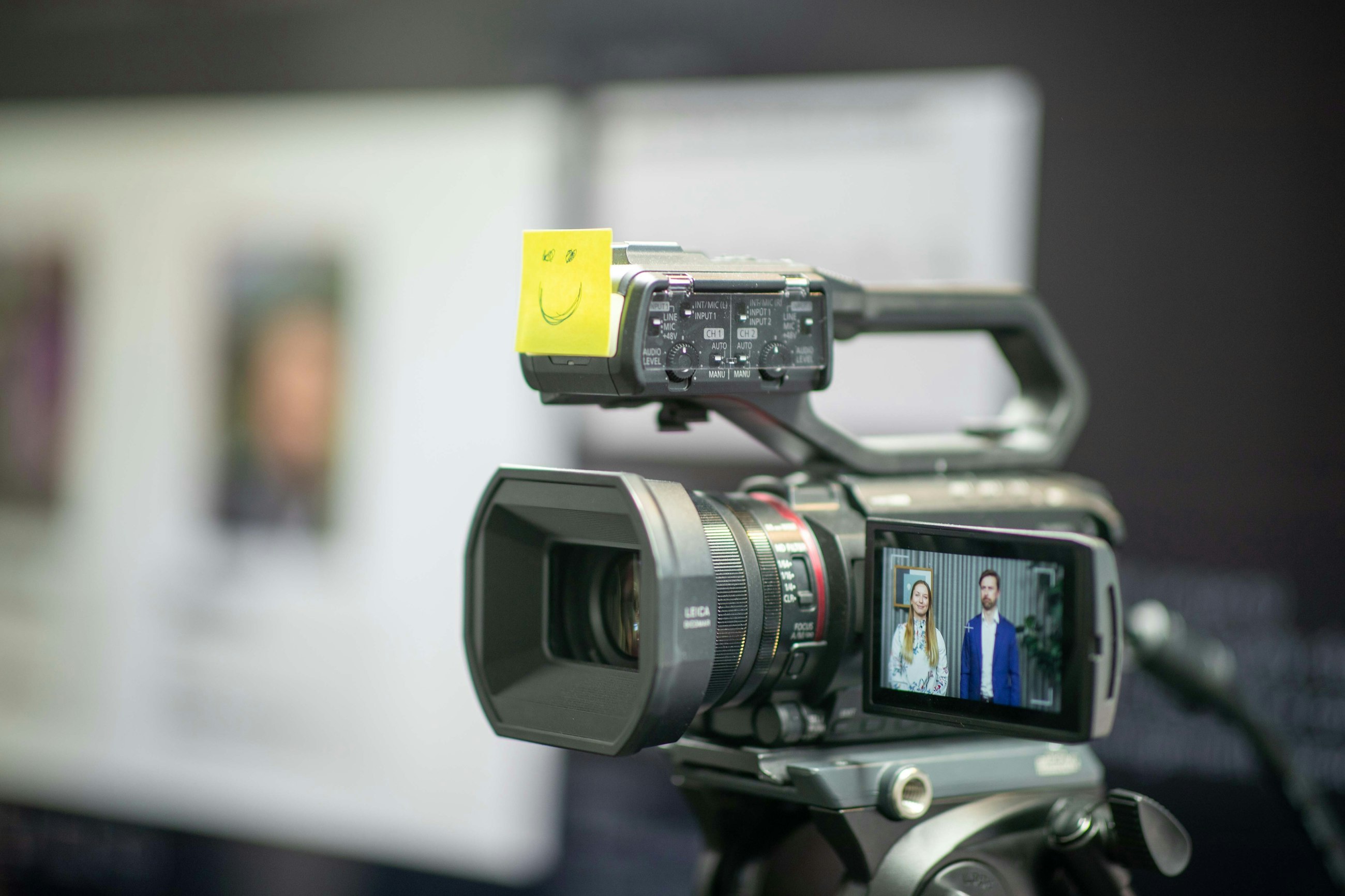How to make the most out of hybrid meetings
This is a translated extract from the recent update to the Danish version of Virtual Facilitation, a book by Henrik Horn Andersen, Iben Nelson and Kåre Ronex, and published by Wiley.
28 June 2021
Hybrid meetings
We were in a meeting room with four colleagues, hooked up on Teams, and three more participants distributed around the country. Our focus was on growing our shared sales activities during a 1.5 hour session. In the room, we were facing the screen and the host of the session who was in the meeting room with us. In actual fact, we were facing the back of the host because he was talking to the camera. The host was asking for comments in the chat from the people participating online, which those of us sitting in the room couldn’t read or post in because we didn’t have our own devices. Also, the participants online had trouble hearing what was said from the physical room as the microphone did not catch all our voices. This meeting was not high quality – nor was it very effective.
This is just a brief illustration of how frustrating it can be when you’re in a hybrid meeting. We have heard many stories similar to this one and noted how people feel frustrated and/or left out, either because of poor quality sound from the physical room, feeling alone because they are not physically part of “the group” or due to a lack of connection with the facilitator. Yet hybrid meetings are the future! There are two reasons for this: first, there are many organisations with a main office and satellite locations scattered nationally or internationally. Second, there are more people working from home to save on the cost of commuting and to give greater flexibility around their working lives. This is why we think this is an important format to look at and improve.
We define a hybrid meeting as a meeting where some participants are physically together in the same room while others are physically apart. However, everyone is connected via a virtual platform. In this chapter, we’re going to explore how you can facilitate a meeting where the participants are together in small clusters and collaborating virtually across locations.
The following is our advice for designing and running hybrid meetings.
Before a hybrid meeting
Our key principle when we look at hybrid meetings is to make all the participants equal. You need to design your hybrid meeting to accommodate all the participants. Don’t make one or other group feel forgotten or “second class”. Your setup and process should work just as well for the people in the room with you as those who are participating alone via the internet. Be aware that the people participating online can feel more alone or as though they aren’t really part of the meeting because of the fact that they are physically disconnected from the others in the group.
Plan for the process to include all participants. This includes ensuring that each person has their own device – including those who are in the room – and an appropriate setup as discussed in Chapter 4. You especially, as the facilitator, should be aware how you set up your computer if you are present in the room. How are you positioned compared to the other physical participants? Even though you have multiple screens, it can be odd not to face each other.
Top tip: In your invitation, be very clear on the fact that participants are expected to be on their own devices with video turned on
Design your process to allow for people in the physical room joining online breakouts and collaboration platforms, and be aware that you might have sound issues if the discus- sions from one person in the physical room can be heard and therefore interfere with one of the other breakout rooms. Think about asking people to have their own earphones as well as their own device or consider using a walk and talk for open discussions in breakout rooms. This also provides some extra energy in the meeting.
If the hybrid meeting is recurring, we recommend also reading Chapter 23 about recurring meetings and using the tips from that. Especially regarding how to design and plan once and then reuse the design.
During the hybrid meeting
Be on top with an appropriate technical setup
One key to success is to have a technical setup that enables you as a facilitator to run the process equally for all participants. Locate your setup (camera etc.) in a way that allows you to speak both to your audience in the room and the people online. Consider using several screens if you need to in order to make sure that you are seen and that all participants can see the screen.
Ensure engagement through individual presence
During the session, be sure that you are all present to ensure engagement from everyone. Be on video – personally – all of you. Sitting alone watching some people as close-ups and others as a pixelated group does not support a good meeting. Everyone needs to ensure a proper individual setup, and it’s your job as facilitator to help and remind them.
When you check in, do it in such a way that everyone is included and gets to speak. Do a round where everyone checks in if you are few in number. If there are more than 6-8 people, then organise into smaller breakout rooms, preferably with a mix of people connecting to the meeting virtually and people physically present in the meeting room. Take care not to exclude either the “physical” or “online” participants.
Connect people in different ways
We recommend connecting people in different ways instead of going for the “physical together and virtual together” option. You can get the participants who are physically together to discuss something, but you should also mix and match across the physical room and the virtual space.
Visualise it so everyone can follow
We prefer to document everything online so that everyone can see it. This means that you need your own device as the facilitator. If you choose to go for old-school documentation, make sure that it is visible and readable on screen. It could be using a flip. Be aware that everyone can contribute – not only the people able to grasp the pen – e.g. you as the facilitator can write inputs on the flip.
Top tip: Use a walk and talk if you want to have breakout conversations between physical and online participants, if you need some fresh air, you want to inject some energy or if the sound is an issue.
After the hybrid meeting
As with any meeting, you should ensure that you get feedback and follow up with participants. As hybrid meetings can be difficult to handle, we strongly recommend that you add time for feedback – both if this is a one-off session or a recurring one. This allows you to get even more inputs on how to ensure high-quality interactions while still providing the flexibility that hybrid meetings offer.
Case
Combined leadership seminar for 25 executives in four locations
Purpose
- To develop the leadership team and the business at the same time by discussing and sharing learnings from three months of coronavirus lockdown and agree on a leadership focus for the organisation going forward.
- To take the next step in a leadership development programme and ignite learning groups and personal development sprints.
Success criteria
- Share and produce five key leadership learnings post-coronavirus.
- Agree on a personal development focus for the next three months.
- Meetings booked for learning group dialogues.
- Participants leave feeling energised and inspired both on content AND in the form of the meeting, inspiring them to do similar things in their own leadership team.
Participants
- 25 top executives covering all business units and support functions of a business with 3,000+ employees across multiple locations, countries and brands.
Platform
- Four physical locations across the country hosting 4-8 participants in each location.
- Teams and video conferencing equipment.
- Phone for walk and talk.
- Shared files (Excel and PowerPoint for tasks).
Process
- A mix of shared online inspirational talks, table discussions in the four physical rooms supported by templates and virtual learning group dialogues across locations, including a virtual walk and talk.
Roles
- CEO setting the strategic direction.
- Facilitators in each room.
- External inspirational talks on leadership and behavioural design sprint.
The solution
The organisation had launched an ambitious leadership development programme for the executive team just before the coronavirus pandemic locked down the countries in which the organisation had operations. After the first two months of firefighting, the CEO realised that it was more important than ever to keep the leadership development process alive.
The solution was to relaunch the programme by spending a day together focusing purely on leadership despite the big business challenges at hand. Due to restrictions, we designed a workshop that was a combination of different ways of interacting – both to create variation and, equally, to inspire the executive team to use some of the forms in their own way of working.
The first part of the day was all about getting together again with focus on strategy and leadership and not operational KPIs. The CEO gave his strategic perspective, which he had shared with the board the day before heading into a QA session, where smaller groups at each location had to produce questions to increase the quality and edge of the questions.
After a break, the physical groups talked about their leadership actions and learnings during the coronavirus period. The instructions were given through Teams, and each physical location had to document their takeaways in a shared PowerPoint file with a template for each group. At the end, each group shared their learnings virtually, and the consultant shared the learnings from other organisations and how to rebound from a crisis with learnings from the financial crisis.
After lunch, the focus shifted towards the individual leader that, through a strict “sprint” process, developed his/her own development activities targeted at changing personal leadership behaviour in the months to come.
To support this, we launched learning groups with people from the different physical locations and connected them through Teams meetings in groups of four and sent them out on a virtual walk and talk. After sharing and refining the development activities, the groups came back to their respective physical rooms and booked different development activities through Excel and Outlook (learning group meetings, Hogan assessment dialogues and coaching sessions). The session was wrapped up with an energetic closing session uniting the four locations as ONE executive team.
Case
Hybrid leadership meeting with eight participants
Purpose
- Fixed weekly leadership meeting for 1½ hours.
Success criteria
- Focusing on and addressing the key leadership challenges for the business.
- Creating a common direction and consistent communication on key challenges.
- Maintaining and developing personal relationships in the leadership team.
- Creating energy for the coming week.
Participants
- Eight leaders in a European leadership team (could also be from the same country but spread out/participating virtually from home).
- Five people in the physical meeting room, two participating virtually from offices in other European countries and one participating virtually from home.
Platform
- Everyone participates on their own computer.
- Participants in the physical room share a microphone/speaker, which means that their computer is muted.
- The meeting is held in Teams and documented in the Teams channel and on a joint Miro board.
Process
- Going through the fixed agenda and ad hoc items.
- Updating the Miro overview of ongoing activities.
The solution
Every Tuesday morning, the leadership team have their weekly leadership meeting. The team leader typically sits in a physical meeting room with 3-4 others and with a similar number of virtual participants from the other offices in Europe and/or participating virtually from home. The meeting has a fixed agenda and is facilitated by one of the virtual participants (they take turns and typically agree on the next facilitator before closing the meeting). The first item on the agenda is always to check in with the participants in terms of how they are doing personally and in their team. The virtual participants always present first followed by the physical participants.
After a short check-in, the facilitator goes through the agenda and asks about other matters that may need to be included during the 1 ½-hour meeting. The agenda is updated on a joint Miro board, which everyone has access to and where you can also write in specific attention points during the week.
The meeting is divided into two parts – one on strategic initiatives and one on operations. Experience shows that it is an advantage to start with the strategic discussions, as the part about operations very easily takes up much of the time. The two parts are fixed in time with a short break in between, but depending on current “cases”, the allotted times are adjusted by the facilitator in agreement with the team.
The team has a simple template which they use to document decisions along the way. The template is updated after each item and is shared in the Teams channel afterwards.
The facilitator is responsible for creating progress and invites the other team members to join and also for keeping focus on a close interaction with the team leader. The meeting is wrapped up with the leader summing up the key points from the meeting and a few other attention points towards next week, thanking the facilitator for the effort and finding someone to chair next week’s meeting.




